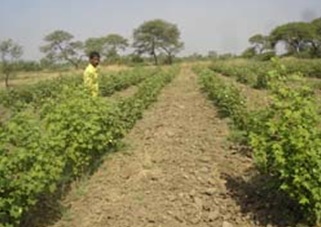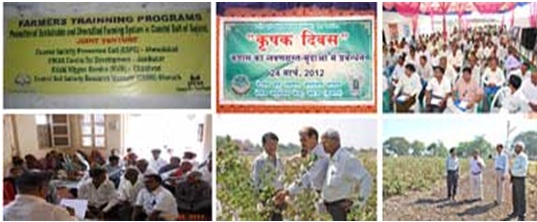Herbaceum Cotton: An ideal option for coastal and inland saline soils of Gujarat
In the coastal district of Gujarat state salinity of the agricultural lands is constantly on the increasing trend.. About 6.73 Mha of land is salt affected in India of which 2.22 Mha is present in Gujarat State only. Economically viable agro-management practices while helping in the management of salt affected black soils and saline ground water in this region would also result in higher agricultural production leading to better economic status of the farmers.
Desi cotton is known for its short staple characteristics, deep root system, resistance to diseases and pests and drought. The ICAR-Central Soil Salinity Research Institute (CSSRI), Regional Research Station, Bharuch (Gujarat) has identified Desi cotton line (G Cot 23) salt tolerant and high yielding after testing over two years. Through field experimentation, the technology of cultivating Herbaceum cotton, G Cot 23 has been evolved and taken on the farmers’ field by the team of scientists. The technology was further tested on farmers’ fields and impact of the technology was assessed.
Technology Adoption:
On-farm Trials were undertaken on farmers’ fields in Bhal area (Rajpara village, Dholera taluka, Ahmedabad district) and Bara tract (Bojadra and Kalak villages of Jambusar taluka, Bharuch district) and Saurashtra (Kodinar, Mangrol and Sutrapada) during 2011-2013 (two years), where G Cot 23 recorded yield of 1.8 to 1.9 t ha-1. Apart from this, cultivation of other desi cotton lines were also taken in in Kalak and Bojadra which also gave seed cotton yield in the range of 1.6 to 1.9 t/ha. Cultivation of Herbaceum cotton lines is now followed in Bhal area, Bara tract and Saurashtra regions on saline soils.On-farm Trials at Dhandhuka taluka
Field trials were also taken up on farmers’ fields with G. Cot 23 on saline Vertisols in four villages namly Rajpur, Mingalpur, Shela and Kamatalav in Dhandhuka taluka of Ahmedabad district indicated seed cotton yields in the range of 1.7-1.8.2 t/ha and the salinity ranged from 9.4 to 10.2 dS m-1.Physical Impacts of Desi cotton cultivation
Continued efforts if ICAR-CSSRI RRS, Bharuch through various NGO partners, resulted in expanding the cultivation of salt tolerant herbaceum cotton (G.Cot 23) in coastal areas of Bharuch, Anand, Ahmedabad and Junagadh districts. Since the performance of salt tolerant cultivars was found remunerative, more number of farm units/farmers had adopted this intervention as evident from increase in number of demonstrations. Since the input costs in desi cotton were much less when compared to hybrids or Bt lines, and also due to their response to saline water irrigation, the desi cottons lines were gaining momentum in the region.Economic Impact
Saline lands having salinity up to 8-10 dS m-1 had been profitably brought under cultivation with Herbaceum cotton, G. Cot 23 in all the three coastal regions of the state. This had resulted in gross income in the range of Rs. 70000/= to 75000/= per hectare and net income of Rs. 45000/= to 50000/= per hectare, particularly in South Gujarat ie., in Bojadra and Kalak with B/C Ratio of 1.8 to 2.0.Technology popularization
Through training programmes farmers were appraised the advantage of desi cotton over other lines, particularly in terms of their low water requirement, high salt tolerance and better response to saline water irrigation. The farmers were given training on soil and water sampling, proper maintenance of the crop. Farmers day were also organized to create awareness among farmers in saline areas about cultivation of desi cotton in salt affected areas for higher production and income.
The NGOs, SAVE (Jambusar), ATAAPI (Jambusar) and MAHITI (Dholera) provided the voice based messages on G Cot 23 cultivation, its cultural aspects to the farmers in selected villages.
Our continued efforts coupled with cooperation from NGOs, SAVE, ATAAPI, MAHITI (through CSPC, Ahmedabad) has resulted in expanding the cultivation of salt tolerant herbaceum cottons in coastal areas of Bharuch, Anand and Ahmedabad districts.
(Source: CSSRI-RRS, Bharuch)

